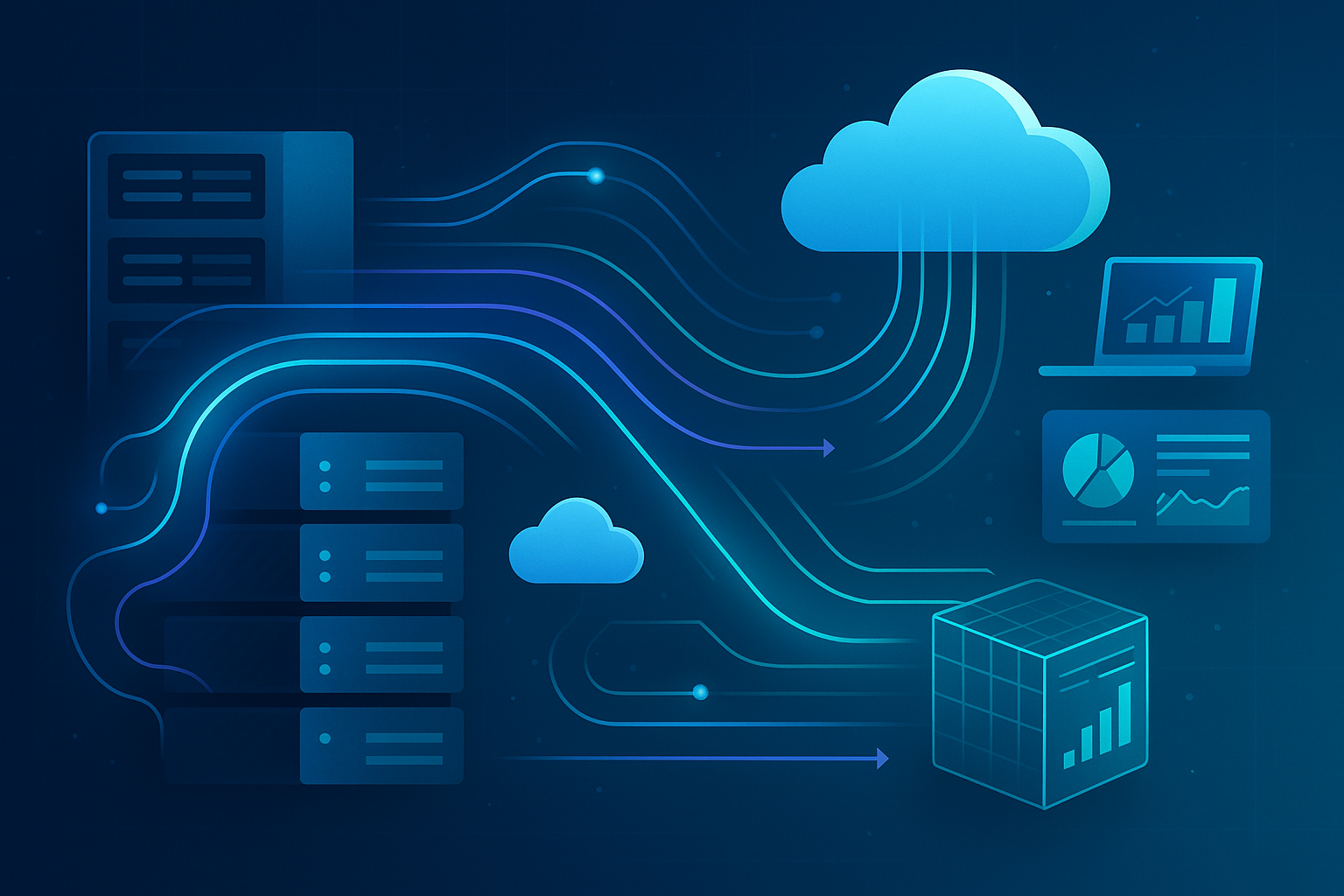Trying to compete in today’s market with an outdated data infrastructure is like entering a Formula 1 race in a car from two decades ago — you might have great drivers, but the machine simply can’t keep up. This is exactly where data modernization comes in: the process of transforming slow, expensive, and rigid systems into agile, scalable platforms ready to meet current demands.
Innovating internal processes and activities, reducing costs and expenses, adopting/implementing new technologies, and advancing the digitalization of operations are four of the seven main management challenges identified by Brazilian executives, according to a survey by the international consulting firm Deloitte. All four can benefit from data infrastructure optimization, as this type of investment means greater speed for innovation, clearer decision-making, and less resource waste.
Data modernization is not just a technological upgrade. It is a strategic shift that aligns performance, security, and flexibility so companies can integrate new technologies, such as Artificial Intelligence, without being held back by the limitations of legacy systems. Those who start now gain the lead — and in the data game, the leader sets the pace. Learn how below.
What is Data Modernization and Why It’s Strategic
. Data modernization is the process of updating, optimizing, and transforming an organization’s data infrastructure, tools, and management processes to make them more efficient, scalable, and ready for current and future demands. Unlike a simple system migration, modernization involves rethinking the entire data architecture — from how information is collected, stored, and processed to how it is made available for use.
In practice, this means replacing legacy structures — often slow, costly, and inflexible — with modern platforms that enable integration, on-demand scalability, and compatibility with emerging technologies such as Artificial Intelligence (AI), Machine Learning (ML), and the Internet of Things (IoT).
Companies that adopt data modernization work with cleaner, more organized, and more secure datasets, reducing bottlenecks and eliminating redundancies. For example, a retailer that once relied on manual , time-consuming reports can, after modernization, access interactive dashboards in seconds, with data automatically updated from multiple sources.
More than just a technological upgrade, data modernization is a strategic evolution that supports a data-driven culture, enabling fast, accurate decision-making based on reliable information.
Key Signs Your Company Needs to Modernize Its Data
Identifying the right time to invest in data modernization is essential to prevent your infrastructure from becoming an obstacle to growth. Below are some clear signs that your company may be falling behind:
Rising infrastructure and licensing costs
Overloaded servers, expensive storage, and poorly optimized software licenses indicate that the current model no longer meets the needs of the business.
Slow dashboards and reports
Queries that take minutes (or hours) to load hinder decision-making and frustrate managers and teams.
Difficulty integrating systems
Fragmented databases and manual processes to unify information slow down analyses and increase the risk of errors.
Incompatibility with new technologies
If your infrastructure cannot support Artificial Intelligence, Big Data, or predictive analytics solutions, it’s time to rethink your environment.
Low scalability
Systems that cannot handle increased users or data volumes limit business growth.
Lack of data governance and security
Poorly documented information and unclear permissions increase the risk of breaches and non-compliance with laws such as Brazil’s LGPD.
Overreliance on a few specialists
When only one or two people know how to operate or understand the infrastructure, the company becomes vulnerable to bottlenecks and disruptions.
Companies that identify two or more of these signs already have enough evidence to consider data modernization a strategic priority — and the sooner this move begins, the lower the costs and impact of the transition will be.
Benefits of Data Modernization for Business
Investing in data modernization goes far beyond replacing old tools with new ones. It’s about creating an information ecosystem that is faster, more secure, and adaptable to market changes. Key benefits include:
Significant cost reduction
By optimizing storage and adopting cloud solutions with on-demand scalability, companies can cut expenses on physical servers, unnecessary licenses, and legacy system maintenance.
Improved performance and faster analysis
Queries that once took hours can now be processed in minutes or seconds, freeing managers to make decisions based on always up-to-date information. This speeds up strategy execution and increases competitiveness.
Scalability to support growth
With modern architectures, processing and storage capacity can grow proportionally to demand without the need for large upfront investments.
Readiness for emerging technologies
Modernization creates an environment compatible with Artificial Intelligence, Machine Learning, and predictive analytics, enabling companies to anticipate trends and automate complex processes.
Enhanced data security and governance
Modern environments offer advanced access control, encryption, and compliance features in line with regulations such as Brazil’s LGPD, helping avoid legal and financial risks.
Strengthened data-driven culture
With more accessible, reliable, and well-structured data, decisions are guided by facts rather than assumptions, increasing accuracy and strategic alignment across departments.
The combination of these benefits transforms the data department from a cost center into a growth engine. Most importantly, it builds a solid foundation for continued innovation in the years ahead, without being held back by the limitations of an outdated system.
Effective Strategies for Data Modernization
Data modernization requires a well-structured plan that combines cutting-edge technologies with best practices in management and integration. Companies that achieve the best results often follow some fundamental strategies:
Cloud migration with on-demand scalability
Using platforms like Azure, AWS, or Google Cloud allows you to scale processing and storage resources up or down according to demand, paying only for what you use. This eliminates high fixed costs and ensures the flexibility to grow without technical barriers.
Optimization of Data Warehouse and Data Lakehouse
Modernizing the storage architecture by adopting more efficient formats, such as Delta Lake, improves performance, reduces storage space, and facilitates integration with multiple analytics tools.
Automation of ETL/ELT processes
Automating data extraction, transformation , and loading reduces manual errors and speeds up report delivery times. Tools like Databricks, Fivetran, and Apache Airflow are strong allies in this process.
Real-time system integration
Adopting connectors and APIs that enable continuous data flow ensures dashboards and analytics are always up to date, enabling faster and more accurate decision-making.
Preparation for Artificial Intelligence and Machine Learning
Structuring data in a standardized, clean format is essential for AI and ML models to be trained with quality, generating predictive insights and intelligent automation.
Implementation of strong governance and security
Establishing clear access policies, encryption, and compliance with laws such as Brazil’s LGPD not only protects sensitive information but also strengthens customer and partner trust.
Focus on the end-user experience
Modernization should not benefit only the IT department. Creating intuitive, fast, and relevant dashboards ensures greater engagement from managers and teams in the data-driven culture.
By adopting these strategies, a company not only modernizes its infrastructure but also creates an environment that supports continuous innovation and agile decision-making, aligning technology with business objectives.
Step-by-Step Data Modernization Process
Data modernization doesn’t happen by improvisation: to ensure returns and minimize risks, it’s essential to follow a structured process that starts with an initial assessment and needs gathering, mapping data sources, bottlenecks, associated costs, and how the infrastructure impacts operations.
With this “X‑ray” in hand, you move on to defining technologies and architecture—choosing among cloud, hybrid, or on‑premises environments, as well as the storage model (Data Warehouse, Data Lake, or Data Lakehouse) and the integration and analytics tools best suited to the context.
Next comes data engineering and integration, the stage in which information is structured, cleansed, and standardized, connecting different systems securely and consistently to enable trustworthy analyses.
Finally, monitoring and continuous optimization are established, tracking performance, cost, and usability metrics to drive ongoing adjustments and improvements.
Following this step‑by‑step approach reduces risk, increases project predictability, and ensures that data modernization is an investment with measurable returns.
Common Challenges in Data Modernization and How to Overcome Them
While the benefits are clear, data modernization can face obstacles that compromise results when there’s no proper planning. Knowing these challenges is the first step to avoiding them:
Resistance to Change
Teams used to old processes may not fully engage with new tools and methods. Without effective change management, adoption can be slow or partial.
Governance and security failures
Migrating to a modern environment without establishing clear access and data protection policies increases the risk of breaches and non-compliance with regulations such as Brazil’s LGPD.
Complex integrations
Legacy systems, often poorly documented, can make integration with modern platforms difficult, requiring more time and technical adjustments.
Lack of alignment with business objectives
Modernizing for modernization’s sake doesn’t generate value. It’s essential that the data architecture be designed to respond to the company’s strategic metrics and needs.
To minimize these risks, the most successful companies take a consultative approach that combines technology, change management, and a focus on the end user. This way, data modernization becomes a smooth and sustainable process rather than a one-off, exhausting project.
That’s why having a specialized team makes all the difference. At Equal, we work from diagnosis to full implementation, ensuring that every step of your data modernization is carried out with safety, efficiency, and focus on your company’s strategic goals.
Avoid waste, cut costs, and prepare your infrastructure for the future. Talk to one of our specialists and find out how to turn your data into a driver of performance and growth.



